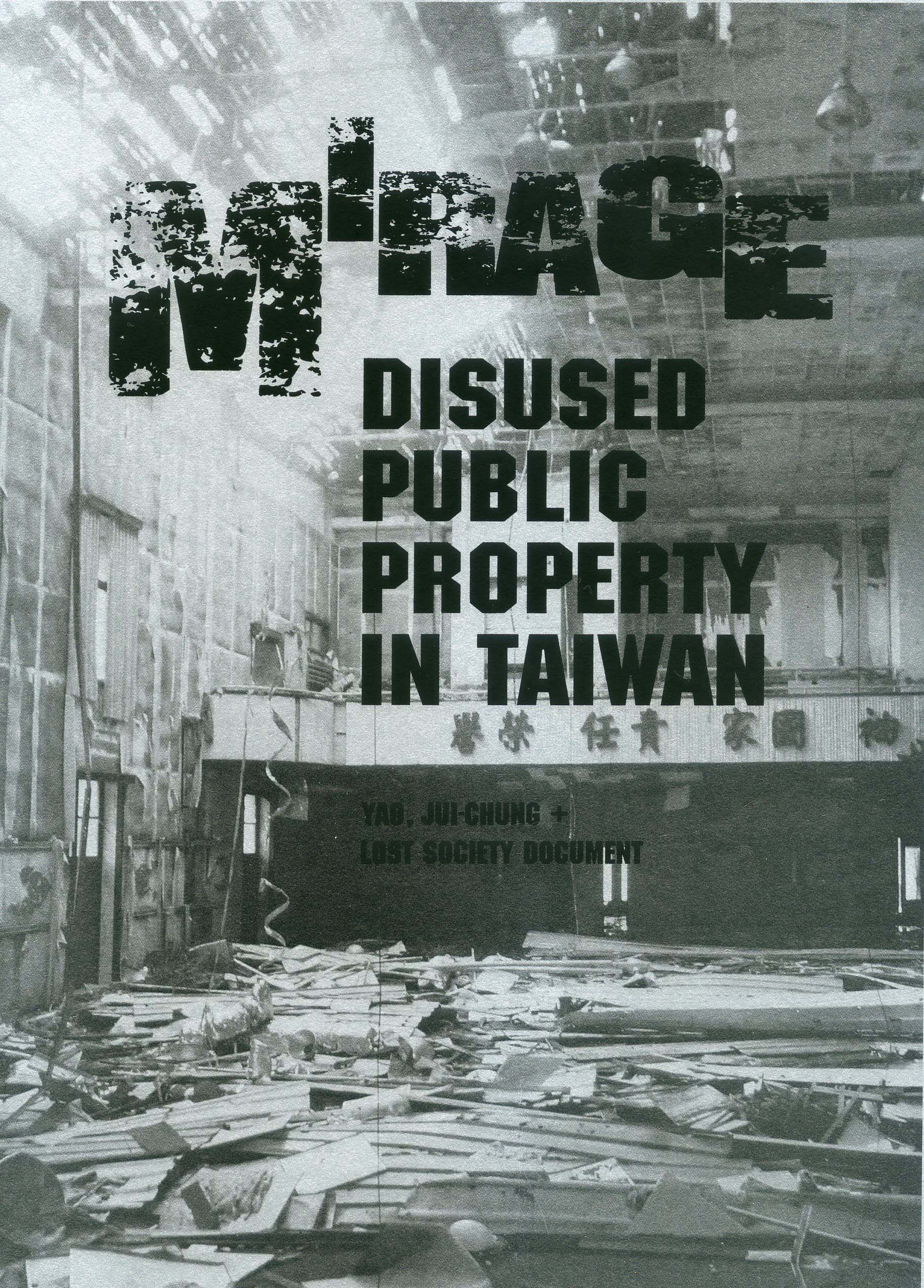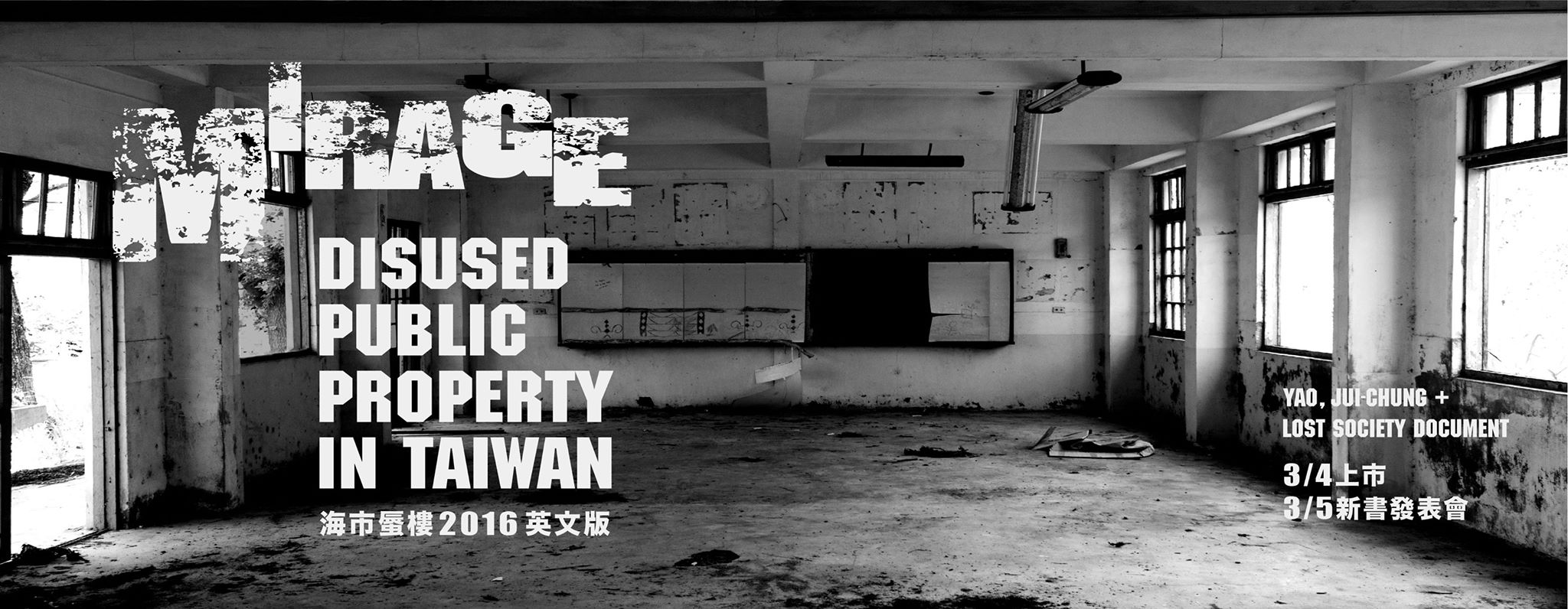For English please scroll down.
This event will be conducted in Chinese.
本活動將以中文進行。
時間:2016/3/5 Sat 3pm
地點:台北當代藝術中心,台北市大同區保安街49巷11
主講人:姚瑞中
與談人:失落社會檔案室
臺灣政府最不願承認的真相──
歷時五年,超過200位學生實地踏查
揭露100件閒置公共設施的崩壞現狀
臺灣各地常可見偌大且無人使用的公共建設,俗稱「蚊子館
姚瑞中
1969年生於台灣台北,1994年國立藝術學院 (國立台北藝術大學)美術系畢業,曾代表台灣參加199
專長為攝影、裝置及繪畫,其作品涉獵層面廣泛,主要探討
著有《台灣裝置藝術1991-2001》(2002)、
失落社會檔案室
為一臨時性組織,由姚瑞中老師號召一堂課的學生組成,以

Time: 2016/3/5 Sat 3pm
Venue: Taipei Contemporary Art Center, No. 11, Lane 49, Baoan Street, Taipei (MRT: Daqiaotou Station)
Speaker: Yao Jui-Chung
In conversation with: LSD (Lost Society Document)
The truth that Taiwanese government was most reluctant to admit
5 years of research by around 200 students
Exposed over 400 cases of disused public facilities
––This book includes 100 selected cases.
Often seen in places around Taiwan, these large and unused public facilities are also known as “mosquito pavilions”. They often arise from inappropriate policies, where government, in the name of expanding internal consumptions and closing the urban and rural gaps, misjudge usage rates, implement inappropriate plans and designs, giving rise to the disused spaces around the country, a practice that till this day still remained. This project was executed by “Lost Society Document” formed by artist YAO Jui-Chung and students, targeting public facilities that cost huge funds in construction over the recent twenty years, every year one hundred cases that required the most attention and review was collected to form Mirage: Disused Public Property in Taiwan, over the past four years four volumes was published. This book selected one hundred critical cases from the four hundred cases exposed by the series, outlining the absurd state of Taiwanese society. In addition to providing the public a reference for reflection, it also allowed youths who have yet to serious observed their hometown to open up an alternative dialogue through the lens of the camera.
Yao Jui-Chung
Yao Jui-Chung was born in 1969. Lives and works in Taipei. He graduated from The National Institute of The Arts (Taipei National University of the Arts) with a degree in Art Theory. His works has been widely exhibited in numerous international exhibitions. In 1997, he represented Taiwan in “Facing Faces-Taiwan” at the Venice Biennale. After that, he took part in the International Triennale of Contemporary Art Yokohama (2005), APT6 (2009), Taipei biennial (2010), Shanghai Biennale(2012), Beijing Photo Biennale(2013), Shenzhen Sculpture Biennale(2014), Venice Architecture Biennale, Media City Seoul Biennale(2014), Asia Triennial Manchester (2014), Asia Biennale(2015) and Sydney Biennale(2016). Yao is the winner of The Multitude Art Prize in 2013 and 2014 Asia pacific Art Prize. We can also find him widely involved in the fields of theatre and films.
Yao specializes in photography, installation and painting. The themes of his works are varied, but most importantly they all examine the absurdity of the human condition. Representative works include Action Series. We can find the clue he explores the question of Taiwan’s identity in Military take over (1994), subverts modern Chinese political myths in Recovering Mainland China (1997), and examines post-colonialism in The World is for All (1997~2000) as well as Long March-Shifting the Universe (2002). In recent years, he has created photo installations combining the style of “gold and green landscape” with the superstitions that permeate Taiwanese folklore, expressing a false and alienated “cold reality” that is specific to Taiwan. Representative works include the series of Celestial Barbarians (2000), Savage Paradise (2000) and Heaven (2001). Another photo installation series Libido of Death (2002) and Hill (2003) tries to probe into the eternal issue of body and soul. Recently, Yao Jui-Chung has assembled all the black-and-white photos of ruins he took in the past fifteen years, grouped under the themes of industry, religious idols, architecture and military bases. They reveal the enormous ideological black hole in Taiwan hidden behind the trends of globalization and Taiwan’s specific historical background as a continuation of the main theme of his work: the absurdity of the historical destiny of humanity. Since 2007, Yao has started to create a series of works including Wonderful (2007), Dust in the Wind (2008~2010), Dreamy (2008~2010), Romance (2009) and Honeymoon (2010~2011). He appropriates masterpieces from Chinese art history and recreates them in his own way, transforming them into his personal history or real stories in an attempt to turn grand narratives into the trivial affairs of his individual life. Yao intends to usurp so called orthodoxy with his recreated landscapes. In 2010, Yao grouped his students into a team of photography workshop called “Lost Society Document”(LSD). He encouraged them to photograph and survey in their hometowns. Through the way of field survey, they attempt to draw the outline of “mosquito houses” which have been widely criticized, publish three books named “Mirage: Disused Public Property in Taiwan”, and practice the possibility of observing the society by the meaning of art.
Apart from creating art, Yao Jui-Chung has curated exhibitions including The Realm of Illusion-The New wave of Taiwan Photography (2002), King-Kon Never Die -The Contemporary Performance & Video art in Taiwan (2003) and Spellbound Aura-The New Vision of Chinese Photography (2004). His essays have been published in many art journals. He has also published several books, including Installation Art in Taiwan since 1991-2001 (2002), The New Wave of Contemporary Taiwan Photography Since 1999 (2003), Roam The Ruins of Taiwan (2004), Performance Art in Taiwan 1978~2004 (2005), A Walk in the Contemporary Art : Roaming the Rebellious Streets (2005), Ruined Islands (2007), Yao Jui-Chung (2008), Beyond humanity (2008), Nebulous light (2009), and Biennial-Hop (2010), “Mirage: Disused Public Property in Taiwan ⅠⅡⅢⅣ(2010~2014). His works have been collected by the Taipei Fine Arts Museum, Taipei, Taiwan; the Kaohsiung Museum of Fine Arts, Kaohsiung, Taiwan; the National Taiwan Museum of Fine Arts, Taichung, Taiwan; Queensland Art Gallery, Brisbane, Australia; Herbert F. Johnson Museum of Art Collection, Cornell University, USA; Bibliothèque National de France, Paris, France (French National Library, Paris); Art Museum of Seoul, and many other private collectors. Now, Yao Jui-Chung works as an artist and teacher at the National Taiwan Normal University Department of Fine Arts.
LSD (Lost Society Document)
When the new semester began in February 2010, Yao Jui-chung, presiding over the first classes of the fine arts departments at Taipei National University of the Arts and the National Taiwan Normal University, asked the students about their expectations for this class: did they wish to follow the normal class format, where the teacher would teach related knowledge, or would they like to use the class to do a “mosquito hall” investigation? The fifty-some students at the two universities decided to make a Taiwan-wide “mosquito hall” survey as the assignment for this semester. Through half a year of investigation across the island, the students identified one hundred and forty seven “mosquito hall” locations, compiling the 684 page book Mirage – Disused Public Property in Taiwan, which outlines an absurd situation in Taiwanese society, embodying the fact that “misguided policy is worse than corruption”. It was widely reported in the media, and attracted a high level of attention from the government, even prompting a call from the Vice President and a visit from the Premier of the Executive Yuan, who advised all relevant departments to engage in an inspection of said facilities, ordering them to revive all mosquito halls within a year or consider demolishing them. Through two years of homework, the students’ art action was like a stone trown into a pond, sending ripples outwards, shaking a presumably calm society and forcing them to face reality. The significance and value of this “participation” lie in the fact that it is both a collective action by Yao Jui-chung and his students, and in that it used artistic methods to hold up a social issue to scrutiny and engage the awareness of the people in regards to that issue.

